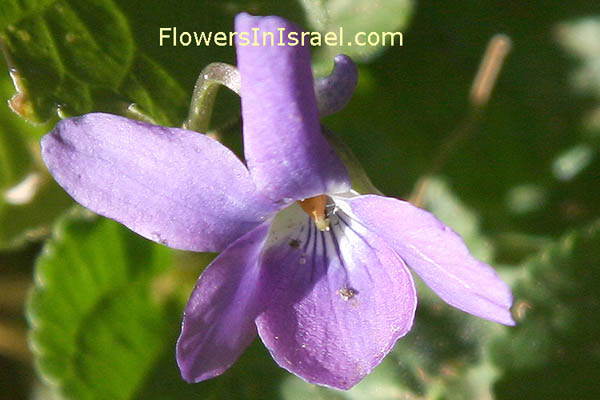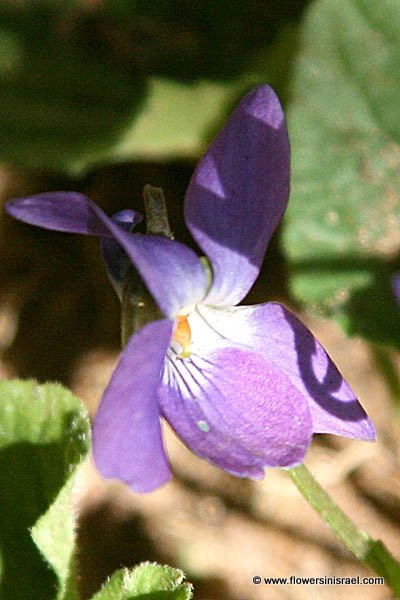Hebrew: סגל ריחני, Arabic: بنفسج
| Scientific name: | Viola odorata L. | |
| Common name: | Sweet Violet, Common Violet | |
| Hebrew name: | סגל ריחני | |
| Arabic name: | بنفسج | |
| Plant Family: | Violaceae, Violet Family, סגליים |

|
| Life form: | Hemicryptophyte | |
| Stems: | 6–15 cm tall; spreading by long, leafy stolons, finely hairy | |
| Leaves: | Alternate, rosette, orbicular, obtuse, entire, dentate or serrate; stipules broadly ovate | |
| Inflorescence: | Scapose; peduncle 4–15 cm | |
| Flowers: | Violet, fragrant; sepals ovate, obtuse; petals deep to pale blue-violet, pale blue, or white, generally white basally, lateral 2 generally bearded with cylindric hairs, lowest 12–22 mm, generally veined purple; spur ± 3 mm | |
| Fruits / pods: | Capsule, globose, 3-valved, puberulent | |
| Flowering Period: | April, May | |
| Habitat: | Mediterranean maquis and forest | |
| Distribution: | Mediterranean Woodlands and Shrublands, Montane vegetation of Mt. Hermon | |
| Chorotype: | Med - Euro-Siberian | |
| Summer shedding: | Ephemeral |

Derivation of the botanical name: Viola, a classical Latin name for violets. odorata, odoro, to smell, give off a fragrance, be perfumed; scented. The Hebrew name: סגל, segal, , Aramaic: סיגלא, sigla. Saul Tchernichovsky (1875 – 1943),a Russian-born Hebrew poet, translated the Russian folk tale of Ivan and Maria into Hebrew and he used the names of אמנון ותמר, AM-non ve TA-mar - Amnon and Tamar. In one of the uglier stories of the Bible Amnon and Tamar were brother and sister and Amnon raped Tamar. This name caught on and is used for the flower to this very day.
Bulwark of Hellas, Athens illustrious." "When we sailed from the blue Piraeus Under the Violet Crown, The sun hung over the mast-head Like Pallas, above the town." The violet was next in estimation to the rose among the ancients, who mention the black and the white sorts. According to legend, Iamos was the son of the nymph, Euadne, and Apollo, an Olympian god. He was abandoned by his mother at birth. She left him lying in the Arkadian wilds on a bed of violets where he was fed honey by serpents. Eventually he was discovered by passing shepherds who named him Iamos after the violet (ion) bed. [Source: Pindar, Pindarus (ca.522–443BCE), Greek lyric poet]. According to legend, Ion was leading his people to Attica and was welcomed by water nymphs, who gave him violets as signs of their good wishes. Thus violets became the city's emblem, and no Athenian home, altar or wedding was complete without them. During the exile of Napoleon I at Elba, in the year 1814, preceding Napoleon's abdication, the French Bonapartists chose, as their emblem, the violet because of the Capitulation of Paris. They nicknamed Napoleon "Caporal Violet, the little flower that returns with spring". The final time Ophelia, a fictional character in the play Hamlet by William Shakespeare (1564-1616), appears in the play, is after Laertes comes to the castle to challenge Claudius over the death of his father, Polonius. Ophelia sings songs and hands out flowers, citing their symbolic meanings although interpretations of the meanings differ. She tells the King Laertes and Queen Gertrude, "I would give you some violets, but they wither'd all when my father died. They say he made a good end" (symbol for faithfulness or fidelity).
|